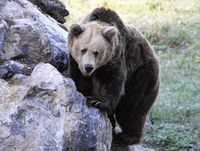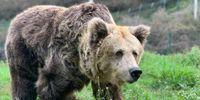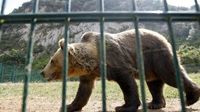On Thursday, April 10, 2025, the Consejería de Medio Rural y Política Agraria made the difficult decision to euthanize Paca, a 36-year-old Cantabrian brown bear, due to her declining health and mobility issues. This compassionate act was taken to prevent further suffering, as Paca's condition had deteriorated significantly in recent days.
Paca, who had been under the care of the Fundación Oso Asturias in the Santo Adriano enclosure, was evaluated by veterinarians who confirmed an irreversible deterioration in her physical state. The latest veterinary report indicated that she was experiencing increasing motor difficulties, with a presumptive diagnosis of arthrosis, a condition that worsened last autumn. The report noted that Paca showed a marked decrease in her reaction to external stimuli and overall physical condition.
Over the years, Paca had received various treatments to alleviate her symptoms, but her situation had recently worsened to the point where she was unable to move, lacked appetite, and exhibited signs of anorexia. The final evaluation concluded that her quality of life was no longer acceptable, leading to the decision to euthanize her.
Paca's journey began tragically in 1989 when she and her sister Tola were orphaned after a poacher killed their mother. At just five months old, they were rescued and placed under the care of the Fondo Asturiano para la Protección de Animales Salvajes (FAPAS). After a brief period in Catalonia and Cuenca, the sisters returned to Asturias in May 1996, where they were housed in a specially designated enclosure known as the Casa del Oso.
For decades, Paca and Tola became symbols of the fight for the survival of the Cantabrian brown bear, a species that had faced near extinction. Their story raised awareness about the plight of the species and helped initiate conservation efforts that have led to a significant recovery of the population in the region.
In the late 1980s, the Cantabrian brown bear population was critically low, with estimates of only 50 to 60 individuals remaining. Thanks to conservation measures, including a complete hunting ban and habitat protection, the population has grown steadily. According to the latest census, conducted in 2020, there are approximately 370 Cantabrian brown bears, with a growth rate of around 10% annually over the last 25 years.
The recovery of the Cantabrian brown bear is considered one of the greatest conservation successes in Spain in recent decades. The population has not only increased in numbers but has also expanded its distribution across an area of 18,000 square kilometers, reaching new territories in Asturias and even coastal regions.
Paca's legacy will endure, as her life and that of her sister Tola helped shape a conservation narrative that continues to inspire efforts to protect the Cantabrian brown bear. The Fundación Oso Asturias noted that Paca's presence in the enclosures and her story played a crucial role in raising awareness and promoting a recovery plan for the species, which, despite progress, remains endangered.
As the only remaining bear currently under the care of the Fundación Oso Asturias, Molina, a female Cantabrian brown bear born in 2013, now stands as a testament to the ongoing efforts to conserve this remarkable species. The future of the enclosure and the potential for more bears in captivity remains uncertain, but the impact of Paca's life will be felt for years to come.
The decision to euthanize Paca has been met with sadness from the community and conservationists alike. Marcelino Marcos Líndez, the Minister of Rural Affairs, expressed his condolences, stating, "It's a sad day. We have lost a symbol of Asturias." He emphasized that the decision was made in the best interest of Paca's health, given her severe condition.
In summary, Paca's life encapsulated the struggle for the survival of the Cantabrian brown bear, and her story will continue to resonate as a reminder of the importance of wildlife conservation and the ongoing efforts needed to protect endangered species.







